Using This Moment as a Catalyst for Digital Business Transformation
Learn how to understand your users intent to personalize the digital experience through Reflected Intelligence. This is part two of a series on the importance of digital experiences when real-life interactions are limited.

My colleague, Justin Sears, recently wrote about the important question being asked across so many businesses right now in light of the unprecedented shifts to social distancing, work from home, and avoidance of public spaces: Can digital experiences replace real-life experiences?
In normal times this has been an interesting question for innovative companies to explore at their leisure. But COVID-19 made it an imperative overnight. Businesses must now improve (or in some cases newly create) their digital experience to continue serving their customers through their websites, apps, and other digital touchpoints.
In Justin’s article, he references a 451 Research report by Sheryl Kingstone entitled “Digital experiences are front and center in coping with coronavirus”, in which she highlights five steps that companies should take in order to build trust, transparency, and retention. Those are:
- Measure digital performance
- Use this moment as a catalyst for digital improvements
- Use virtual assistants to ease capacity issues
- Focus on retention by moving to subscriptions
- Make sure you can take mobile orders and deliveries
I’d like to spend some time on the second bullet and highlight key ways in which you may be able to “use this moment as a catalyst for digital improvements” in your own business to create a digital business transformation.
If you haven’t already, check out Garrett Schwegler’s piece on the first bullet: measuring digital performance.
Bringing Personal Touches to Digital Experiences
While some companies may have no digital footprint, the vast majority have at least a small website or social media page where customers can interact with their brand. Retailers and those selling products will typically have more advanced websites through which customers can search through and purchase products online, serving them without any necessary in-person contact. Unfortunately, these digital commerce experiences are usually very transactional: a customer shows up to the website or app, searches for an item, purchases the item, and then the item is delivered or picked up. Other than a series of one-time purchases, very little is done to foster a meaningful, long-term relationship.
With in-store experiences (most of which are temporarily unavailable), customers have the ability to interact with employees, ask them questions, and build personal relationships and trust. Employees, likewise, learn patterns from customers about their needs, which products different kinds of customers prefer, and how to answer common questions. Employees further build social relationships with repeat customers, learn their interests and preferences, and use that knowledge to make customers happier.
I personally love that restaurants I frequently visit know my “usual” order, and that I can ask questions of the experts at the electronics store as I browse the isles. I love that sales associates at my local hardware store will even proactively ask me questions about the projects I’m working on. They ask me about the products I’m purchasing to ensure I know what I’m doing (I often don’t!) and then point me toward alternatives that might serve me better.

While it is, of course, very challenging to replicate this kind of “human connection” online, many of the other benefits of these in-person interactions can certainly be translated to the digital experience.
Digital platforms can remember past shopping activity and purchases, predict my preferences, give me personalized recommendations, ask me questions about what I need, and harness the knowledge of countless other shoppers whom I will never meet to pick the best product combinations for me. These are all areas where digital technology can actually achieve, and in many cases improve upon, the in-person experience.
Opportunities for Digital Improvement
At Lucidworks, we help hundreds of the world’s leading organizations achieve these very goals by capturing each and every customer interaction as a digital moment – a signal about the customer’s intention, needs and preferences. Customer interactions include things like searches, clicks, views, purchases, bookmarks, likes, and reposts of content. We call these user interactions “signals” because they signal a user’s intent and interests.
Modern data systems, like Fusion, can use machine learning (ML) to learn about users’ intent from these signals and then reflect that knowledge back to improve future search results. This process is called Reflected Intelligence.
Reflected Intelligence is all about creating feedback loops that constantly learn and improve based on evolving user interactions.
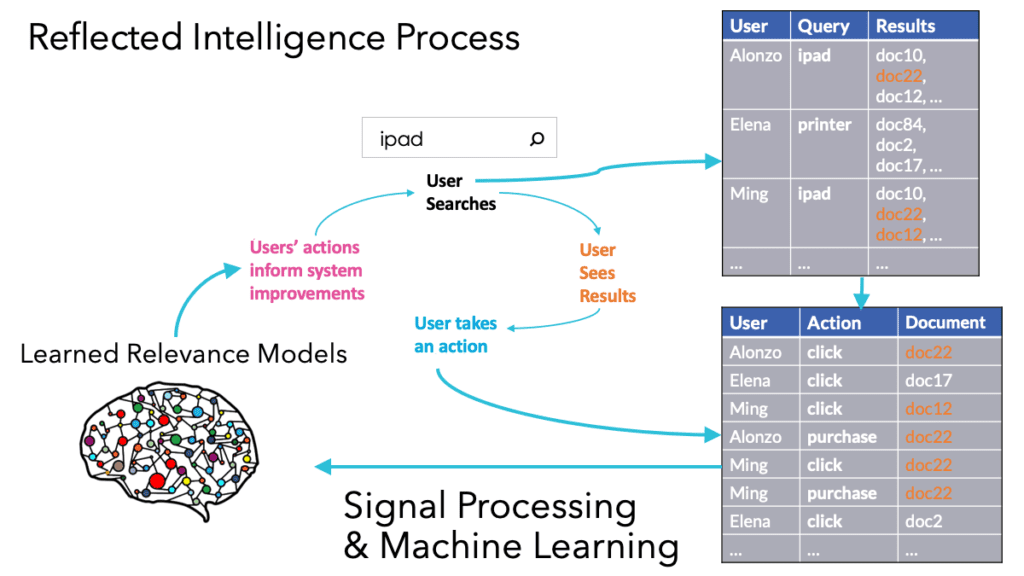
The Reflected Intelligence process typically plays out as shown in the diagram above. A user runs a search (for “ipad” in this case), sees some results, and then takes an action (such as a click or purchase). The system then takes those queries and actions, performs signal processing and machine learning, and creates learned relevance models that apply to future user searches to make them better.
Reflected Intelligence Through Signals Boosting
One popular example of a learned relevance model is a Signals Boosting model. The purpose of this model is to learn the most popular products for each query, based upon the collective interests of all of your customers. This is the digital equivalent of an employee who learns to recommend popular products based upon lots of conversations and interactions with customers in the store. The signals boosting model can take it one step further and get much more specific and understand the optimal results of all of your most popular search queries.
Customers who search for something (an item name, a brand, a question, or any other product attributes or keywords), will be frustrated if you show the wrong result. Some may adjust their query or browse long enough to find what they are looking for, but many will probably leave and look somewhere else. By tracking the satisfaction of customers with each result and the subsequent actions they take on those products (for example, making a purchase), it is possible to boost the “best” products to the top of search results for future users.
Reflected Intelligence uses wisdom gained through interaction with the many similar users who came before, just like my buddy Josh who runs the local hardware store. This ensures your digital experience is automatically tuned and improved as customers interact with it.
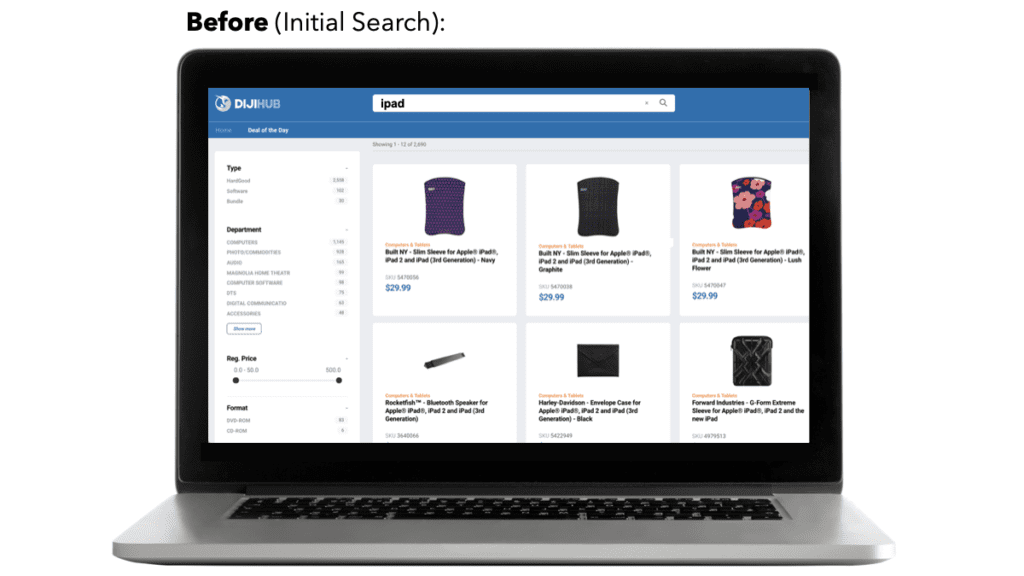
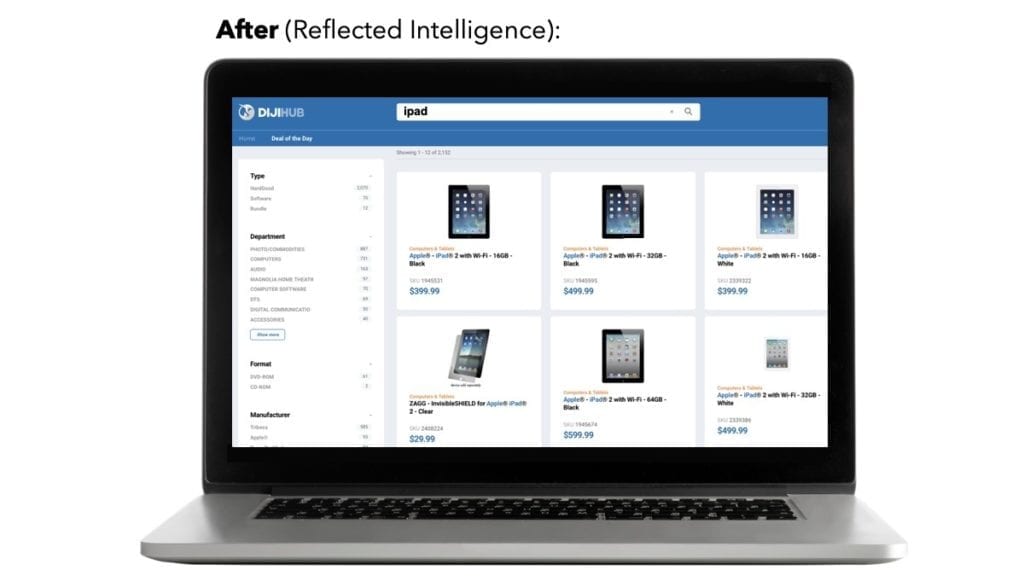
In the above example, an initial static search for “ipad” returned results for iPad cases and other accessories, which are poor results based upon a simple keyword match. By learning the collective feedback of your customers using Reflected Intelligence and then boosting products based upon that intelligence, you demonstrate your business’s expertise and ability to understand your customers’ wants and needs (even when they’re sheltered in place).
Additional Types of Reflected Intelligence
While the previous example boosted the best products based upon user interactions, a Reflected Intelligence process can also learn many different kinds of patterns and models. For example:
- When multiple people search for a keyword and then change a few characters and search for a similar keyword, ML models can learn a common misspelling.
- When many people search for the same or similar keywords, ML models can learn your business terminology, including common phrases, entities, and related synonyms.
- When customers who interact with one set of items commonly interact with another set of items, ML can learn to recommend similar items. This can include recommendations for:
- individual users
- similar products
- most popular items
- similar queries
- trending items
- products frequently purchased together, or
- any number of other similar suggestions that can guide your customers toward a more successful and engaging digital experience.
- When a single person interacts with items sharing similar attributes, Reflected Intelligence can learn their personal preferences (such as favorite brands, colors, or topics) and use those to personalize future interactions.
As an example of some of these learned patterns, you can see in the following search for “samsung black laptopo“, that the query “laptopo” has its spelling corrected to “laptop”, that “laptop” is then identified as a category, that “black” is identified as a color attribute, and that “samsung” is then identified as a brand. Each of these can be learned based upon a comparison of the incoming user signals and how customers typically use each of those keywords relative to the actual attributes of your products.
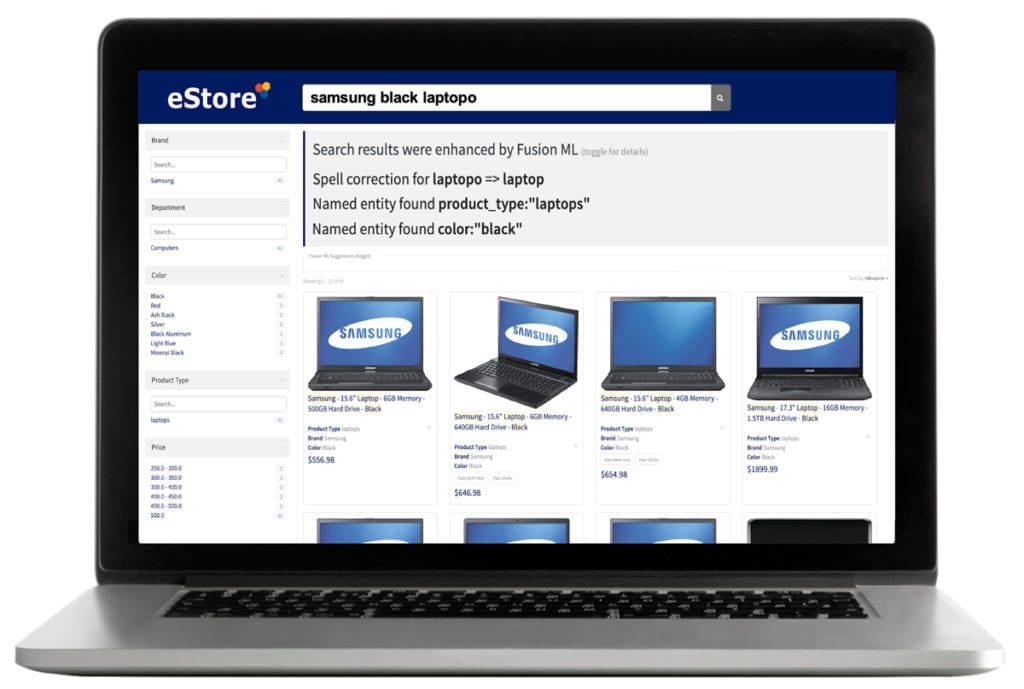
As a further example, consider a traditional keyword search for “harmony”. Without leveraging Reflected Intelligence, this query is likely to return results for various music albums. By analyzing the term in the context of real customer usage, however, the Reflected Intelligence layer is able to learn that Harmony is actually most commonly used as a brand name for a line of universal remote controls made by the company Logitech:
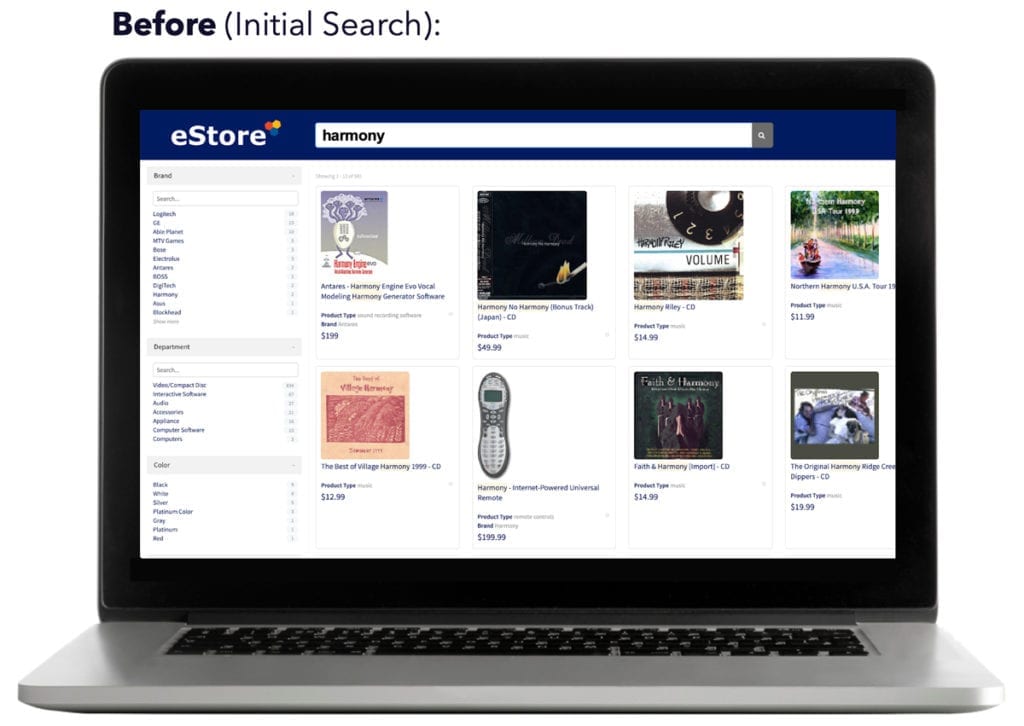
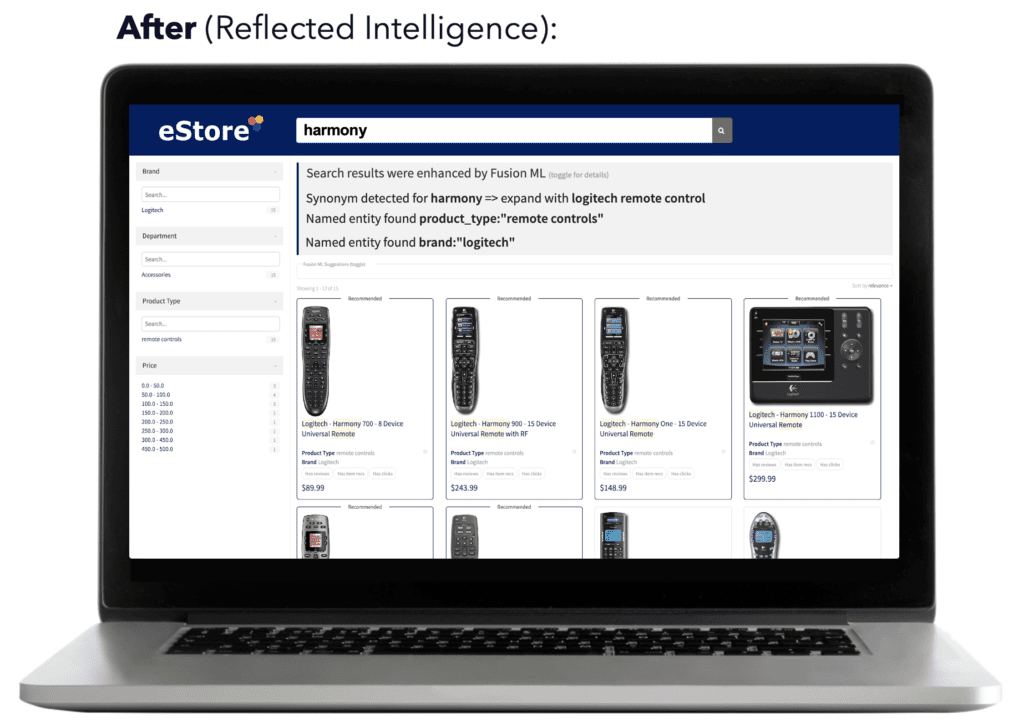
The following image demonstrates the output of a few additional Reflected Intelligence models that can be learned from your customer data:
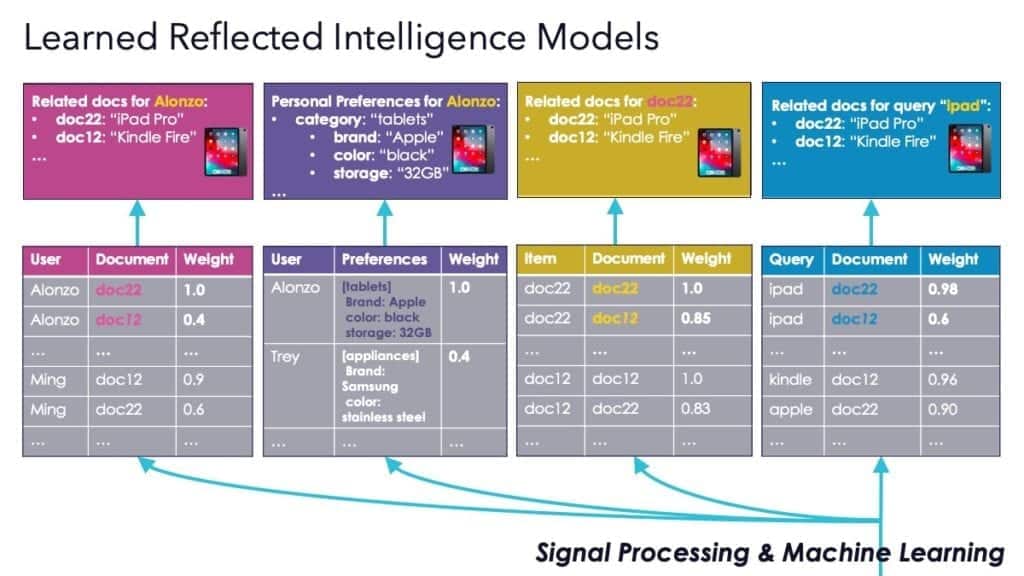
The first of these (pink) demonstrates personalized recommendations for your customers, based upon their signals. You could show these on your homepage or use them in an email campaign to encourage each customer to return to your website.
The second model (purple) shows the learning of individual preferences for each customer, which can be used to personalize your website, communications, and search results based upon the customer’s interests.
The third model (yellow) shows related product recommendations, which can be shown on the product details page when the customer is viewing each product to suggest alternatives.
The fourth model (blue) shows related documents for a query, which can be shown while the user is typing their query as type-ahead suggestions, as signals boosted search results, or as alternative recommendations on the search results page in case the search does not otherwise return the expected results.
These dynamically-learned models demonstrate just a few of the many ways that you can harness the value of your customer interactions to create more meaningful, nuanced, and personalized interactions within your digital experience. We consistently see double-digit improvements in conversion rates among clients who leverage our Fusion platform to implement these capabilities.
Digital Business Transformation Beyond Retail
I’ve discussed techniques to transform your business to more effectively engage retail customers. But the reality is that these same techniques also apply to almost every digital experience. Customers are also looking for optimized customer support experiences, including searching through your frequently asked questions, documentation, or product help forums.
For example, by implementing these Reflected Intelligence techniques, one of our Fusion customers was able to reduce click-through rates within their customer success portal by over 200%, resulting in 50,000 fewer customer support tickets being filed, significantly less support calls, and higher customer satisfaction. These improvements were based on the exact same underlying content as before, but now optimized to learn from customer interactions to return more relevant results.
Time and time again we see this level of impact when implementing these kinds of digital experience enhancements, and the 451 Research report cited earlier also identifies that this opportunity for improving digital experiences is worth at least “$500 billion in revenue in the US alone.”
Implementing these Reflected Intelligence techniques is also incredibly important in your digital workplace. Every day, your employees are searching for documents and for internal experts with relevant knowledge and expertise. The better you are at helping them find the right information (ideally in a unified user experience), the more productive your employees and business will be. Your employees spend thousands of hours identifying content, searching for subject matter experts, and otherwise connecting the dots between all of your organization’s internal knowledge. If you give them a dramatically more productive and rewarding experience, they can get more done and enjoy the work more.
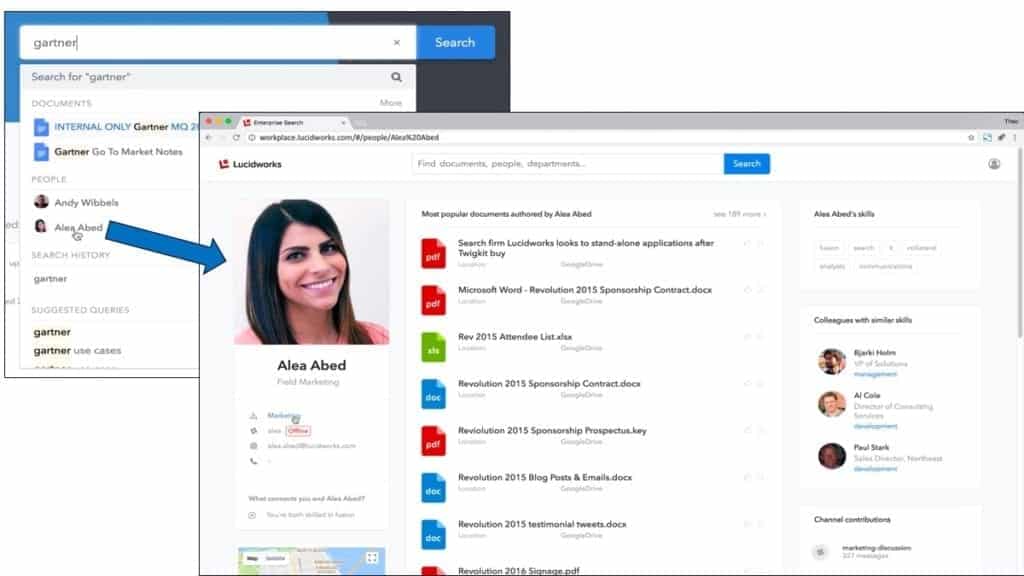
To quote again from the 451 Research report:
Heightened demands for context, convenience and control in all customer interactions require companies to re-evaluate how they provide contextually relevant – and in situations such as the current crisis, sensitive – experiences for their customers. In effect, this is forcing the evolution of the entire technology stack and organizational culture to enable real-time, contextually relevant experiences.
…
Considering that 48% of the market is still formulating its digital transformation plans, businesses have a long way to go to ensure that vision meets reality. However, there has to be a specific reason to start – finally there is a business case for many to wake up, especially when it comes to delivering contextual experiences.
Lucidworks is partnering with our clients to adapt to COVID-19’s economic impact and to position them for better growth both now and after the current crisis subsides. With their customers and prospects sending them more digital signals every day, expressing what they want, our clients can capture those behavioral signals and continuously deliver the most contextually-relevant digital experiences as usage patterns evolve.
If your business could use help aggressively enacting this kind of digital business transformation and you would like to learn more, please don’t hesitate to reach out.
LEARN MORE
Contact us today to learn how Lucidworks can help your team create powerful search and discovery applications for your customers and employees.